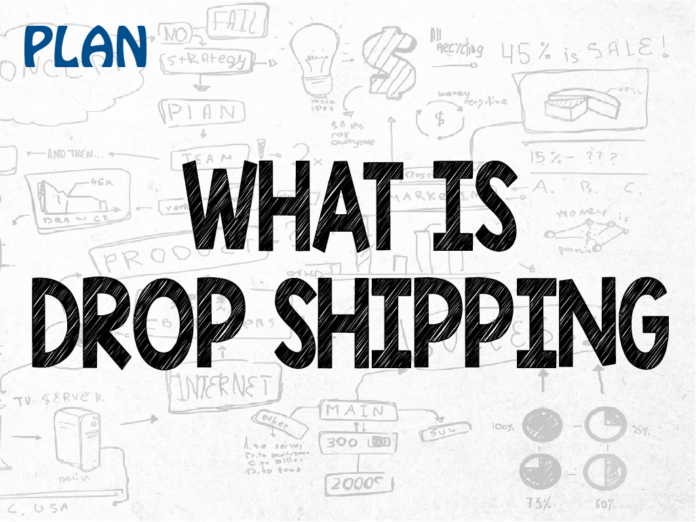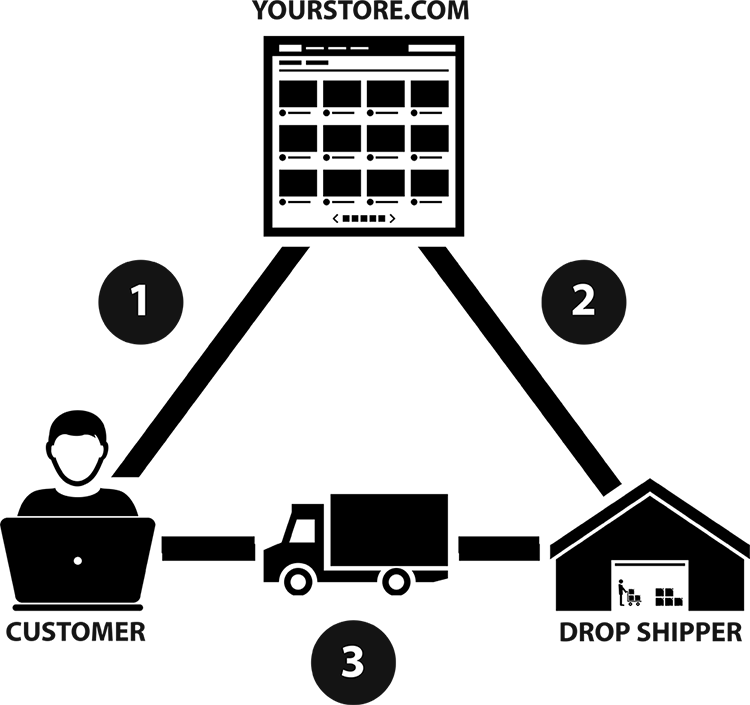In this post we will cover the fundamentals of what drop shipping is, the advantages and disadvantages, who it’s for, the profit margins and the risks associated with the business model.
What Is Drop Shipping?
Drop shipping is both a sourcing and fulfillment business model where the retailer (you) never actually own the inventory you’re selling. Instead, you’re acting as a middle man that sells the goods on your own website and when you receive an order, you pass that order onto the drop shipping company for them to pick, pack and fulfill. Your profit is the difference between what you charge your customers on your website and what the drop shipping company charges you.
How Does Drop Shipping Work?
Drop shipping is fairly straightforward but we’ve created the image below to give an overview of what a drop shipping transaction looks like.
- A visitor arrives at your online store (YourStore.com) and makes a purchase.
- You receive the order and either manually or automatically forward that order on to your drop shipping partner.
- Your drop shipper packages the order and sends it to your customer on your behalf.
The Benefits of Drop Shipping
The biggest benefit of drop shipping is the very low startup cost and the ability to offer a large selection of products without purchasing inventory upfront and managing that inventory. Drop shipping can also be a great tool to help diversify your inventory and test products since it’s just a matter of adding the new product to your store.
The drop shipping business model has a number of advantages, including:
- Lower Capital Requirement: With drop shipping, you don’t need to invest thousands of dollars into inventory. Instead, you only purchase a product when you have an existing order to fill.
- Wider Product Selection: When you don’t have to pre-purchase all the items you sell, you can offer a significantly larger number of products to your customers.
- Reduced Risk: Without thousands of dollars invested in inventory the risk involved with starting an online store is dramatically reduced. If things don’t work out you aren’t stuck with thousands in inventory you have to sell at a loss.
- Location Independence: Because you don’t have to worry about fulfillment or running a warehouse it’s possible to run a drop shipping business from anywhere with a laptop and an internet connection.
- Highly Scalable: Because you don’t need to manually fulfill each order it’s relatively easy to scale a drop shipping business. The work is almost the same for you whether you sell 5 units or 500 units.
The Disadvantages of Drop Shipping
Drop shipping can be a great startup business model, but it’s not without disadvantages and drawbacks. Some of the most notable disadvantages of this business model include:
- High Competition: One of the biggest challenges with drop shipping is the ubiquity of products available through drop shipping suppliers. The trade-off for easy access to products is that many people will flood the most popular marketplaces with popular items.
- Low Margins: Margins for drop shipped products tend to be slim. This can make it difficult to compete with manufacturers and retailers with larger margins.
- Low Level of Brand Control: Because you don’t touch or ship the products yourself, you have a lower level of control over the brand experience.
The Difference Between a Manufacturer and Drop Ship Wholesaler
It’s easy to get confused between all the terms when you’re searching for a drop shipping supplier. Many times it seems like they are used interchangeably, but there’s differences between each of them and it’s important to know those differences.
A manufacturer actually manufacturers the end product that you are purchasing. Some manufacturers will have a drop shipping program in place where you can partner directly with them. This is ideal because there are no middle men so you will usually be getting the best prices which means you can get the greatest profit margins.
A drop ship wholesaler is someone that purchases products from the manufacturer and then drop ships them on behalf of you (the retailer). Many times manufactures just want to focus on manufacturing and don’t want to deal with selling to small companies so they will sell in bulk to a drop ship wholesaler who will then create a drop shipping program for retailers like you to join.
A slightly different term you may come across is a drop ship aggregator. A drop ship aggregator like WorldWideBrands is essentially a wholesaler that partners with hundreds of manufacturers and makes it easy for you to add products from those hundreds of manufacturers to your own store.
While this sounds good in theory, a drop shipping aggregator like WorldWideBrand takes a cut of your margins for this service. Being that drop shipping inherently already has slim margins, this makes it extremely difficult to build any sizable business. In addition, these aggregators usually charge hundreds of dollars in yearly fees.
Note: We personally do not recommend or support using any drop shipping aggregator service at this time.
Who Is Drop Shipping For?
There are a few types of entrepreneurs that the drop shipping model will work well for. Let’s take a look at some of them:
Validating Entrepreneur: Drop shipping can be a great way to test new products or even a new startup before investing heavily into inventory that may not sell, making this the perfect business model for the entrepreneur that requires a high level of business and product validation before investment.
Budget Entrepreneur: Drop shipping is definitely the least expensive method of selling online because you don’t have to purchase any inventory upfront. Because of this, the drop shipping method works well for entrepreneurs that have a limited budget or would prefer to keep startup costs as low as possible.
First Time Entrepreneur: The drop shipping model for selling online also is a good business model for someone just starting out selling online. The fact is, selling online isn’t easy. Driving traffic and converting that traffic for the average marketer can take a long time to figure out and optimize. Because of the low costs associated with starting a drop shipping business, it allows new entrepreneurs to start to learn the ropes of setting up a store, driving traffic and conversion optimization before investing thousands (or more) in inventory that you may get stuck with.
Walmart Entrepreneur – Drop shipping is also for the person that wants to sell a wide variety of products and models. Depending on what the price range is of the products you intend to sell or if you want to sell hundreds or thousands of different products it’s nearly impossible without massive funding to acquire all that inventory. In this case, drop shipping would be the appropriate model because, again, you don’t need to purchase inventory upfront.
There’s also a few types of entrepreneurs that drop shipping isn’t for:
Brand-Centric Entrepreneur – Building a long-term sustainable brand is difficult but the rewards can be incredibly worthwhile. However, building a brand while utilizing the drop shipping business model is exponentially more difficult as there are so many elements of the entire customer experience that you won’t be able to control. For example, many times you may find out that after a customer has purchased something from you it’s sold out with your drop shipper. This leaves you in the bad position of trying to coordinate between your customer and your drop shipper and can become a really poor experience for your customer. Another point to keep in mind is because you’re not shipping the product yourself you don’t have any control over the experience of your customer receiving the package. Almost 100% of the of time it’s going to be the product in a big brown box with packing peanuts. You need to ask yourself if that’s the experience you want your customers to have. Finally, because you don’t ship the products yourself you don’t own the relationship with the shipping companies. When something does go wrong and your customer doesn’t receive the package you can’t simple call UPS and get the situation corrected. You need to coordinate this with a busy account rep which could take days to sort out, again, leaving your customer with a bitter taste in their mouth.
Margin Focused Entrepreneur – Probably the biggest problem with the drop shipping business model is the razor thin margins. Generally, for traditional drop shipping products and companies your gross margins (the price you sell it for minus the cost you pay your drop shipper) are around 10-20%. At the end of the day when you pay your credit card transaction fees, shipping cart, email service and other app fees you will be looking at only a few percent. I’ve met my fair share of online entrepreneurs running 1 million dollar revenue per year drop shipping businesses that at the end of the day are making 40-50k profit.
Non-Creative Marketers – Most manufacturers (which can also be drop shippers of their own products) have sales goals in which 30% of the sales need to come from direct-to-consumer sales, usually through their own ecommerce site. This means that if you’re selling their products, you will be competing directly with your own supplier, a supplier that is able to have much higher margins than you on the very same products. Any chance of competing head-to-head against them is pointless. They will almost always win because they can afford to. If you’re going to beat your own supplier you need to be creative and find and exploit channels they aren’t using to acquire customers. If your only ideas are to use Google Adwords and Facebook Ads, you’re likely out of luck.
Drop Shipping Margins
Your profit is the difference between what you charged the customer and the price the drop shipper charges you. Typically with drop shipping your profit margins are slim, around 20%. Keep in mind that after all other business expenses, like advertising and overhead costs, you are usually looking at just a few percent profit.
Drop Shipping Risks
Drop shipping is pretty low risk in terms of potential financial loss because you never buy inventory up front nor do you have to worry about shipping product, however, risk comes in the form of very slim margins and high levels of competition. Slim margins mean you have to move a lot of units to make decent profit. Compounding that, the slim margins diminish your ability to profitably carry out certain marketing activities like pay-per-click to acquire new customers.
Is Drop Shipping a Dead Business Model?
Ten years ago, drop shipping was a thriving business model however in recent years, as it becomes increasingly easy to set up an online store, drop shipped products have saturated the market. This is making it more and more difficult to compete with other drop shippers.
Additionally, customers are demanding a more premium brand experience that drop shippers currently aren’t able to keep up with.
Although the business model is far from dead, it’s much more difficult to build a large and thriving business using the drop shipping model. In order to give yourself the best possible chances of success with drop shipping you’ll want to have a laser focus on the products you choose to sell and should work directly with manufactures as opposed to drop ship aggregators to get the best possible margins on your products.
How To Be Successful Drop Shipping
More than ever, if you decide to go the drop shipping path, you’ll really need to specialize in a specific niche. Retailers that decide to utilize drop shipping tend to be more successful the more they specialize in a certain niche. Many new entrepreneurs think that by narrowing the focus of their products, their customer base will be limited along with revenue and profits.
The reality is quite the opposite: by narrowing your product focus you also narrow your ideal customer which helps focus your marketing and decrease the cost of customer acquisition.
Additionally, working directly with manufacturers that drop ship can help you maintain the healthiest margins by cutting out middle men.
Overall, drop shipping is a great model to get started building online businesses, however, it’s become increasingly more difficult to build a sizable business and compete effectively.
































